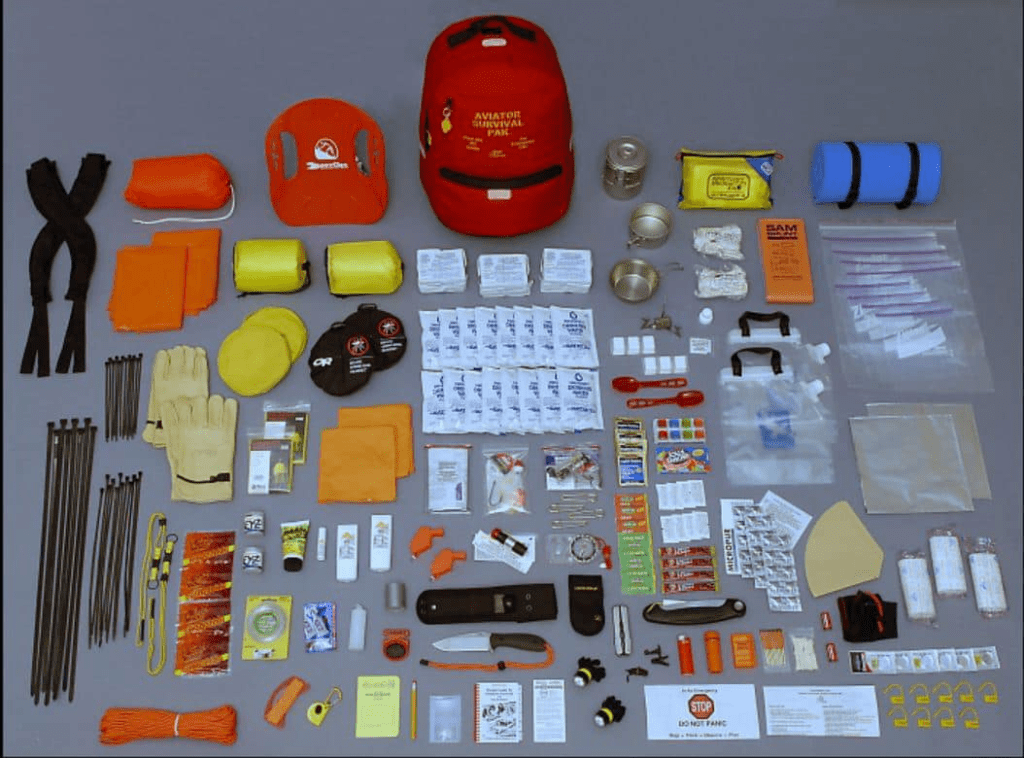
An aircraft survival kit typically contains essential items to aid in survival during an emergency situation. The specific contents may vary depending on the type of aircraft, the intended use, and regulations of the country or airline. However, here are some common items that are often included in aircraft survival kits.
- Emergency Locator Transmitter (ELT): A device that emits a distress signal to help search and rescue teams locate the aircraft in case of a crash or emergency landing.
- First Aid Kit: Basic medical supplies such as bandages, antiseptics, pain relievers, and other essential items for treating injuries.
- Water Packets: Small, sealed packets of water or water purification tablets to ensure a safe drinking water supply when stranded.
- Food Rations: Non-perishable food items like energy bars, ready-to-eat meals, or vacuum-sealed food pouches that provide sustenance during an extended period of survival.
- Survival Blankets: Lightweight, compact blankets designed to retain body heat and provide insulation in cold environments.
- Signal Mirror: A small mirror that can be used to reflect sunlight and attract attention from search and rescue teams.
- Whistle: A loud whistle that can be used to alert others to your presence or signal for help.
- Flashlight or Headlamp: A portable light source with extra batteries to provide illumination in low-light conditions.
- Multi-tool: A versatile tool that combines various functions such as a knife, pliers, screwdriver, and other tools useful for survival situations.
- Fire Starter: Waterproof matches, lighters, or fire-starting tools to help build a fire for warmth, signaling, and cooking.
- Personal Protection Equipment: Disposable gloves, face masks, and other protective gear for personal safety and hygiene.
- Compass: A navigational tool to help determine directions and aid in finding your way to safety.
- Waterproof Bag: A durable, waterproof bag to store and protect the survival kit contents from water damage.
- Life Raft: In aircraft that operate overwater or in remote areas, survival kits may include a life raft. These rafts are designed to provide flotation and shelter in case of a water landing or ditching. They may contain additional supplies such as fishing gear, signaling devices, and water desalination kits.
- Life Vest: Life vests or personal flotation devices (PFDs) are typically provided on commercial flights for each passenger. They are designed to keep individuals afloat in the water and often come equipped with whistles, reflective tape, and lights for increased visibility.
- Fishing Kit: In survival situations where food is scarce, some aircraft survival kits may include a compact fishing kit. It can contain fishing line, hooks, and sometimes basic instructions on how to catch fish for sustenance.
- Water Purification Tablets: To ensure a safe drinking water supply, small water purification tablets may be included in survival kits. These tablets can help disinfect and purify water from natural sources, making it safe for consumption.
- Personal Locator Beacon (PLB): In addition to an ELT, some survival kits may include a PLB. These handheld devices transmit distress signals via satellite to alert rescue authorities to your location.
- Insect Repellent: In areas with a high risk of insects or mosquitoes, survival kits may include insect repellent to help prevent bites and reduce the risk of insect-borne diseases.
- Sunscreen: To protect against sunburn and harmful UV rays, sunscreen may be included in survival kits. It is particularly important in open or exposed environments where shade is limited.
- Emergency Radio: A small, battery-powered emergency radio can be included to receive weather updates, emergency broadcasts, and communication with rescue teams.
- Duct Tape: Duct tape is a versatile item that can be used for repairs, securing shelter, or improvising tools or equipment.
- Compass and Map: A detailed map of the surrounding area, along with a compass, can help with navigation and finding your way to safety.
- Gloves and Hand Warmers: In cold environments, gloves and hand warmers can help protect against frostbite and keep hands warm.
- Distress Signal Devices: Depending on regulations and the specific survival kit, additional signaling devices like flares, strobe lights, or handheld signaling mirrors may be included to attract attention during rescue operations.
It’s important to familiarize yourself with the contents of the specific survival kit provided on the aircraft you are traveling on, as different aircraft types and jurisdictions may have varying requirements and regulations regarding survival equipment.
By Aeropeep Team





